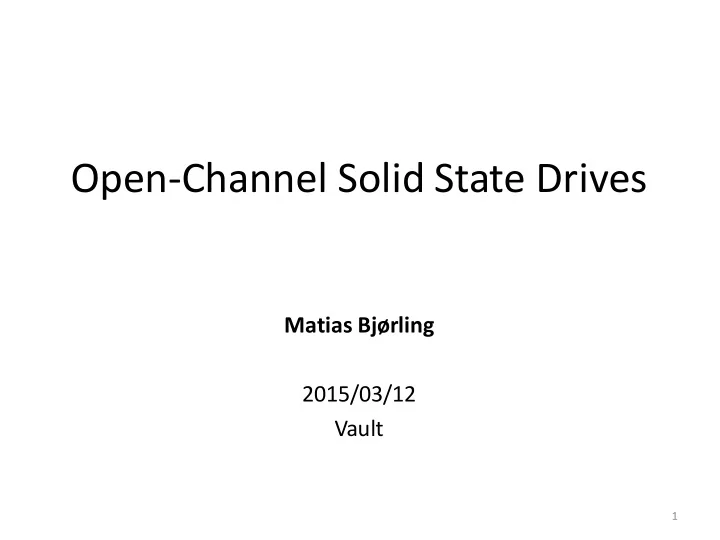

Open-Channel Solid State Drives Matias Bjørling 2015/03/12 Vault 1
Solid State Drives • Thousand of IOPS and low latency (<1ms) • Hardware continues to improve – Parallel architecture – Larger flash chips • Replaceable for traditional harddrives • Embedded software maintains complexity 2
Embedded FTLs: No Future • Dealing with flash chip constraints is a necessity – No way around some form of FTL • Embedded FTLs were great to guarantee adoption, but have critical limitations: – Hardwire design decisions about data placement, overprovisioning, scheduling, garbage collection and wear leveling – Based on more or less explicit assumptions about the application workload – Resulting in redundancies, missed optimizations and underutilization of resources 3
Market Specific FTLs • SSDs on the market with embedded FTLs targeted at specific workloads (90% reads) or applications (SQL Server, KV store) • FTL is no longer in the way of a given application • What if the workload or application changes? • What about the other workloads or applications? 4
Open-Channel SSDs Physical flash exposed to the host (Read, write, erase) Host • Data placement • IO Scheduling • Over-provisioning • Garbage collection • Wear levelling 5
Where are Open-Channel SSDs useful? • Data centers with multi-tenancy environments • Software-defined SSDs – Managed storage centrally across open-channel SSDs. – NAND flash shared at fine-granularity • Applications that have specific needs can be serviced by a FTL tailored to their needs (Application-driven FTLs). 6
New Logical Abstractions • How is flash exposed to the host? – Traditional Flash Translation Layer • Both metadata and data are managed by the host – New interfaces • LUNs (The parallel unit of SSDs) • Key-value database (e.g. LevelDB and RocksDB) • Object-store (OSSD) • Application-driven (New research area) • File-system (NVMFS) • Hybrid FTL (Traditional FTL is expensive, offload metadata consistency to device) – Manage multiple devices under a single address space • Including garbage collection (Global FTL) 7
What should the host know? • SSD Geometry – NAND idiosyncrasies – Die geometry (Blocks & Pages) – Channels, Timings, Etc. – Bad blocks – Error-Correcting Codes (ECC) • Features and Responsbilities 8
Kernel Integration • Generic core features for flash-based SSD management such as: – List of free and in-use blocks, handling of flash characteristics, and global state. • Targets that expose a logical address space, possibly tailored for the needs of a class of applications (e.g., key-value stores or file systems) 9
Architecture User-space Kernel VFS File-systems Page Target Key-Value Target Block Layer Open-Channel SSD Integration Null device NVMe PCIe-based SATA/SAS Open-Channel SSDs 10
Responsibilities 11
Hybrid Target • Host-side Translation table and reverse mapping table (for GC) in host • Device maintains metadata consistency – Offloads metadata overhead at the cost of disk also maintaining translation table • Sequential mapping of pages within a block • Cost-based garbage collection • Inflight tracking – Guarantee atomicity of writes 12
Hybrid Target per Request Component Description Native Latency(us) LightNVM Latency(us) Read Write Read Write Kernel and fio Submission and completion 1.18 1.21 1.34 (+0.16) 1.44 (+0.23) overhead Completion High-performance SSD 10us (2%) time for devices Null NVMe hardware device 35us (0.07%) Common SSD 100us ( 0.002 %) System: i7-3960K, 32GB 1600Mhz – 4K IOs Low overhead compared to hardware overhead 0.16us on reads and 0.23us on writes 13
Key-value Target Throughput (GB/s) 1 MB Writes 50 Metric Native LightNVM LightNVM 40 -Page Key-value 30 Throughput 29GB/s 28.1GB/s 44.7GB/s 20 Latency 32.04μs 33.02μs 21.20μs 10 Kernel Time 66.03% 67.20% 50.01% 0 Throughput Native LightNVM-Page LightNVM Key-value Kernel time overhead 30% serving 1MB writes. Opportunities for application-driven FTLs 14
Industry Vendors • MemBlaze – Available hardware • PMC Sierra – Builds support in user-space • IIT Madras – Builds HW using RapidIO SRIO • Stealth startups and others – Storage Arrays – Applications 15
Source Layout • Open-channel SSD initialization – /block/blk-nvm.c – Initialization/Registration – /include/linux/blkdev.h – Common NVM structures • Targets – /drivers/nvm • Round-robin page-based with cost-based GC FTL (rrpc) 16
Open-channel SSD initialization • Device drivers register the block device as an Open-channel SSD device – Device is queried for geometry and configured • blk_nvm_register(struct request_request *, struct blk_nvm_ops *) • struct blk_nvm_ops – identify – get_features – set responsibility – get l2p – erase_block 17
Block Layer Structures /includes/linux/blkdev.h • struct nvm_dev (1 per device) – Describes the characteristics of the device • struct nvm_lun (N per device, 8-16) – Information about luns and status of flash blocks • struct nvm_block (M per device, 1024+) – Information about each flash block state 18
Target Interface • Uses the interface provided by the block layer – blk_nvm_get_blk(struct nvm_lun *) – blk_nvm_put_blk(struct nvm_block *) • Target reserves flash blocks and writes data • Reads can either be resolved by device or physical LBAs • Implements target_type interface – make_request, prep_rq/unprep_rq, init/exit 19
RRPC Flow Read IO from /dev/ Target RRPC nvm0 1. Direct to /dev/ nvme0n1 submit_bio 2. Setup target context bio complete 1. Unlock logical blk_mq/ submit_bio address sq_make_request 1. Lock logical address unprep_rq 2. Lookup LBA to PBA prep_rq 3. Setup physical addresses in request blk_mq_end_request queue_rq 20
Future • Integrate with – Ceph – RocksDB – Percona – Openstack – And many others • Kernel upstream • Finalize interface specification together with vendors https://github.com/OpenChannelSSD 21
Thanks for Listening https://github.com/OpenChannelSSD 22
Recommend
More recommend